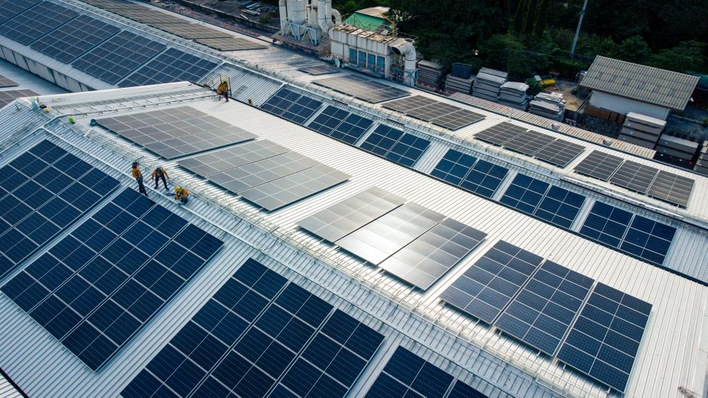Solar is a clean affair: That is the promise of the photovoltaics industry, on which millions of solar customers in Europe and around the world rely. For the vast majority of installations, this requirement applies without reservation. However, there are more and more cases in which solar generators interfere with the protected radio bands of emergency services or amateur radio as a result of interference signals.
The number of cases is manageable, but it is rising. "In fact, OFCOM notes that the number of interference reports due to photovoltaic systems is increasing," says a statement from the Swiss Federal Office of Communications (OFCOM) in Biel. If a solar system interferes with the protected frequencies, the operator is usually issued a warning by these authorities. Then he has to remove the interference from the system - how to do that is his business. If he does not comply with this request, the authority can force the installation to be shut down.
The inverter as a source of interference
First of all: Interference signals can occur from any electrical equipment. Properly manufactured and certified solar inverters have appropriate filters on the DC side. However, if the device is defective, disturbing harmonics can be transferred to the DC strings. In that case, the usually very expansive DC cabling on the roof acts like an antenna: It becomes a jamming transmitter. "Normally, the DC side of a photovoltaic system consists of one or more strings with solar modules connected in series, which are connected to one or more MPP tracker inputs on the inverter," explains Swiss photovoltaic expert Heinrich Häberlin. "If the RF interference voltages measured at these MPPT inputs are below the threshold values of the applicable standard, in practice there is usually no unacceptable interference.
Häberlin is no stranger to the solar industry: Retired in 2015, as Professor of Electrical Engineering at the University of Applied Sciences in Bern, he has inspired several generations of students to study photovoltaics. He has been active in photovoltaic systems technology since the end of 1987. He has published several standard works in the solar industry, specialist books and over 150 articles on photovoltaics.
A potential problem became real
Häberlin was and is also an enthusiastic ham radio operator. "As an active amateur radio operator, it was already clear to me at the beginning of my research activities that photovoltaic systems were a possible EMC problem. I pointed this out in my test reports already in the early 90s."
Related article:
Inverters with integrated yield optimization versus module optimizers
In the meantime, there are some cases on record in which EMC problems have been proven to have occurred. And in which the authorities became active. They forced the operators to eliminate the unacceptable interference signals.
Häberlin was instrumental in defining limit values for the DC-side emissions of inverters. "In the event of any malfunctions, it is easy to attach additional interference suppression devices to the MPPT inputs of the inverters," he explains. "The number of interference sources is relatively small - essentially the number of MPPT inputs plus one, so the cost of interference suppression is acceptable".
DC optimisers exacerbate the problem
The situation is different in systems with DC optimisers: "There, for each one or two modules, there is an additional interference source dispersed in the solar generator, i.e. a large number of different HF interference sources," the expert explains. "An attempt should therefore be made to use switching designs with the lowest possible generation of interference (soft switching).
The large number of potential sources of interference in the extensive DC circuit of the solar modules is extremely disadvantageous: "In terms of high frequency technology, the solar generator is a transmitting antenna with undefined RF characteristics in terms of impedance and antenna efficiency for each optimiser," Häberlin says. "Some optimisers will be able to transfer their interference power almost completely to an antenna resonating on the interference frequency. Others will not be able to deliver the full interference power due to a mismatch."
Separate interference suppression filters required
This means: If the system malfunctions, all sources of interference must be excluded. "For technical reasons, a proper interference suppression therefore requires separate interference suppression filters on each optimiser, which results in additional costs," comments Häberlin. "As far as I know, the manufacturers have so far produced normal, undisturbed optimisers and, in the event of interference reports, simply install additional interference suppression devices on each optimiser."
These are, for example, three folding ferrites with three bifilar windings with asymmetrical HF impedances of 0.5 to two kiloohms - at each optimiser in the interfering string. "These measures, which up to now have had to be carried out by the installer in the event of faults in the cabling and the subsequent interference suppression elements exposed to the elements under the modules, are unsightly," says the expert. "It would be desirable if these suppressors were integrated as standard directly into each optimiser or housed in a weatherproof external additional housing supplied by the manufacturer with short connection cables and plugs. This could be delivered and installed free of charge in case of an incident."
He sees a further possibility in special, EMC-compliant optimisers with integrated suppressors, which would have slightly larger housings and which would be available under a special part number.
In Part 2, Heiko Schwarzburger goes into further detail of what can possibly be done about such interference signals.







